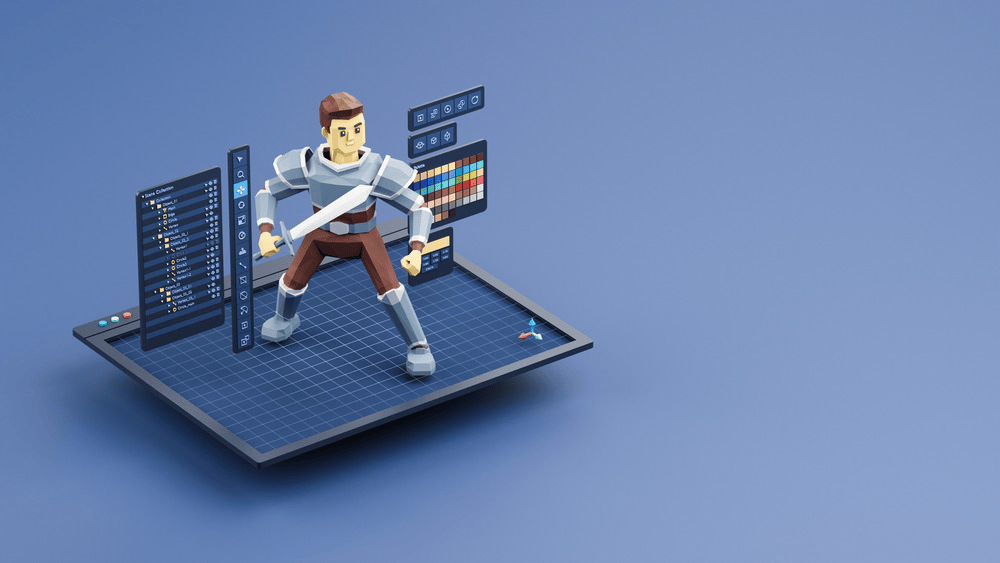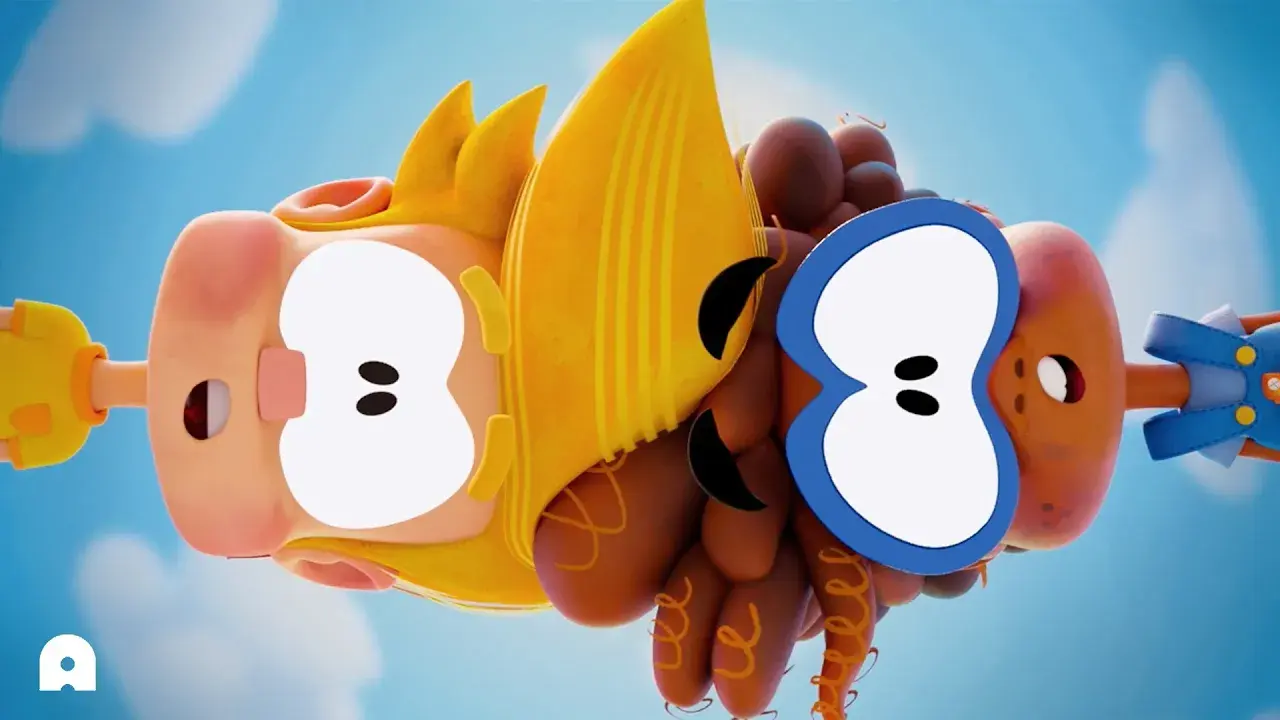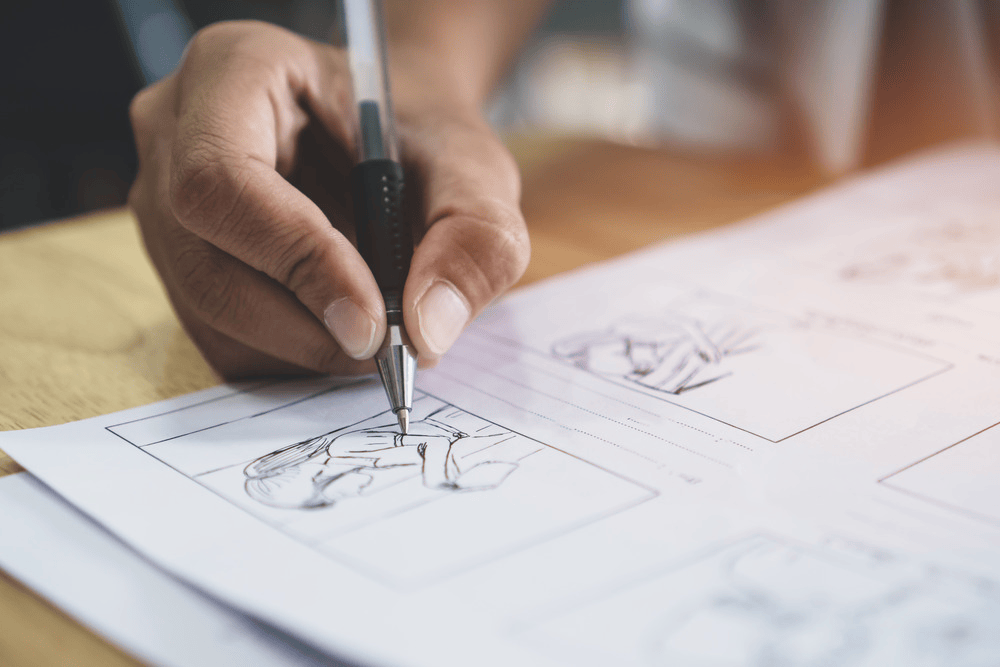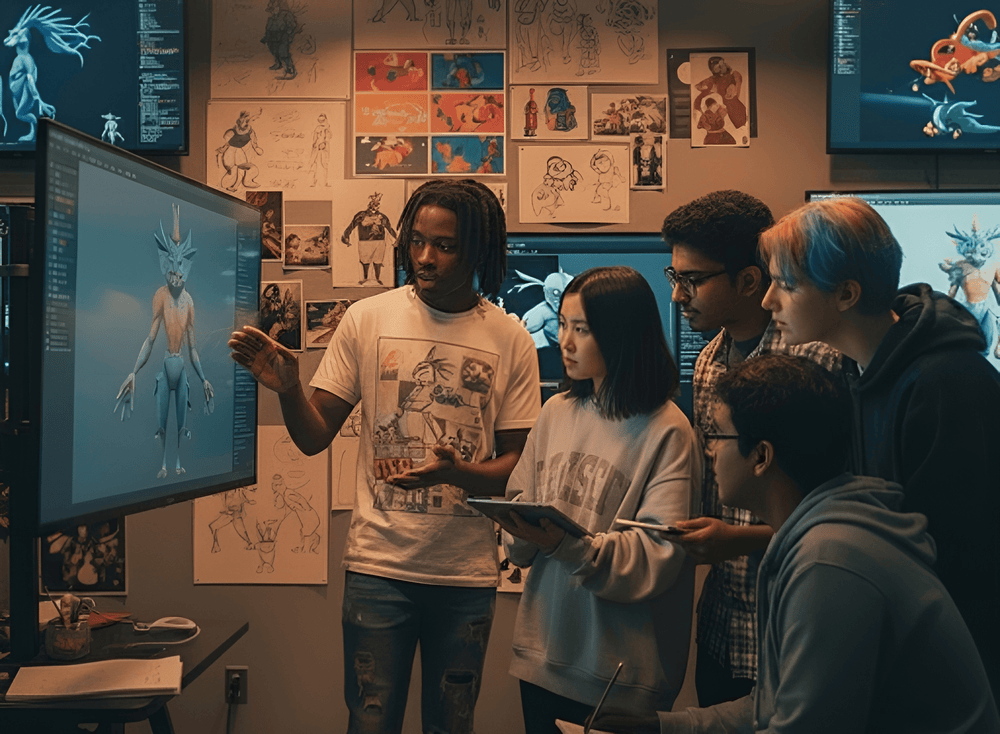Love animation and video games? A career in game design could be your perfect fit. Game designers are the creative minds behind the stories, characters, and worlds that players get lost in.
If you enjoy building characters and bringing ideas to life through movement, game design allows you to take that one step further by shaping how the whole game plays out. An animation background gives you a major head start.
Keep reading to learn what a game designer does, what employment options are available in the industry, how animation skills support a career in game design, what’s happening in the South African gaming landscape—and more.
What Does a Video Game Designer Do?
Do you ever find yourself spending countless hours playing the same game? That’s all thanks to the work of video game designers. Video game designers are the creative directors of the gaming industry. They’re responsible for defining the game’s look and feel, the way the story unfolds, and the challenges and rewards that keep players engaged.
Game designers decide the game’s central concept or story, main characters, and setting or environment. They also determine the gameplay mechanics (or rules and systems) that shape the player’s experience. These mechanics range from the actions players can take and what they need to do to win or finish the game, to the way the game responds to player interactions.
Game designers work closely with artists (including animators), writers, and game developers to translate their vision into a working product people will enjoy playing. In summary, video game designers are storytellers, world-builders, and problem-solvers, combining creativity with technical knowledge and leadership skills.
Game Designer vs. Game Developer
While game designers and game developers both play key roles in bringing a video game to life, their responsibilities are very different.
A game designer focuses on the vision of the game. They define the story, characters, setting, and the rules that guide the player’s experience. Their job is to make sure the game is fun, balanced, and engaging.
A game developer, on the other hand, handles the technical side, writing the code that makes the designer’s ideas work. Developers build the systems that control everything from character movement to how the game world responds when a player takes an action.
In practice, designers and developers work side by side. Designers shape the concept, while developers make it work. On small teams, one person may take on both roles, but in larger studios, they are distinct jobs that require close collaboration.
Industry Opportunities for Game Designers
Game design is a versatile skill set that opens doors across a range of creative industries. From blockbuster studios to indie games, mobile apps, and educational tools, designers can find meaningful work in spaces that match their passions and strengths.
Let’s take a look at some of the video game employment options available to game designers.
Mainstream Gaming (AAA Studios)
AAA studios (also known as Triple-A studios) are large companies that produce high-budget, high-profile games for consoles and PC. AAA studios produce some of the most popular and visually impressive games in the world.
Examples of AAA game studios include:
Working in a Triple-A studio means contributing to massive global projects in a structured studio environment.
In an AAA studio job, you’ll typically be part of a big team, with opportunities to learn from experienced professionals and specialise in areas like level design, systems design, or gameplay mechanics.
While these roles can be highly competitive, they offer exposure to major franchises and cutting-edge tools.
Indie Game Development
Indie game studios are typically made up of smaller teams working on original and creative projects. Designers in this space often wear many hats, combining design, storytelling, and even basic coding and user testing.
Indie studios offer a great environment for creative freedom and rapid skill development, especially for those who like to experiment and innovate.
Examples of indie game studios include:
Indie development is a good path for aspiring game designers who want creative freedom and the chance to shape projects from start to finish.
Mobile Gaming
With millions of people playing games on their phones daily, mobile gaming is one of the biggest and most accessible platforms for new game designers. It requires a strong focus on user experience and short-form gameplay design.
Examples of mobile gaming studios include:
Mobile game design is a great training ground for rapid iteration and design thinking. It focuses on intuitive gameplay, player retention, and creative monetisation strategies that don’t disrupt gameplay (most mobile games are free to play but include optional microtransactions).
Educational and Serious Games
Game design also has many applications beyond entertainment, as games are increasingly being used in applications such as education and training.
These “serious games” combine gameplay with real-world objectives like skills acquisition, behaviour change (e.g. habit building), or even driving social change. By delivering information in a fun, interactive format, these games make learning more engaging and memorable.
Examples of studios making serious or educational games include:
- EdInventa, the Spanish studio behind HeroMask, a VR-based game for learning languages and mathematics
Designers in this space need to balance learning outcomes with gameplay to keep users engaged while meeting real-world goals.
Freelance vs. Studio Work
Not all game designers work in traditional studios. Freelance work has become a popular path, especially for those who enjoy flexibility or want to build independent games.
Studio roles offer stability, access to large teams and resources, and a higher chance of working on big-budget, mainstream titles.
Freelance designers, on the other hand, might work on smaller projects, take on contract roles, or develop and publish their own games. While freelancing can be more unpredictable, it allows for more creative freedom and hands-on involvement in every part of the design process.
Up next, we’ll take a look at what routes a career in game design might take.
Game Designer Career Path
Let’s explore some of the entry-level, mid-level, and senior positions a game designer might experience as their career path unfolds.
Entry-Level Roles
Most people start their game design careers in junior or support roles that focus on building practical skills and gaining experience. These roles are a chance to get familiar with studio pipelines, understand how games are made, and work under the guidance of more experienced designers.
Common entry-level roles include:
- Junior Animator: Creates simple character or object animations to support gameplay and cinematic scenes
- Junior Game Designer: Assists in designing levels, gameplay mechanics, or user interface elements
- 3D Artist: Creates game assets like props, environments, or characters using modelling and texturing tools
- Environment Artist: Focuses on building immersive, explorable game spaces and setting the visual tone
- Junior Quality Assurance Tester (QA Tester): Performs playthroughs to test gameplay for bugs and gives feedback on mechanics and player experience
These positions help new designers build a portfolio, learn industry tools, and gain insight into the collaborative nature of game development.
Mid-Level Roles
With experience, designers move into more focused and creative roles that allow for greater ownership over the game’s systems and storytelling. These positions often involve leading small teams or owning specific features or elements of the game.
Examples of mid-level roles include:
- Gameplay Animator: Designs and polishes how characters move and react in-game
- Cinematic Artist: Creates in-game cutscenes and scripted sequences to support storytelling
- Systems Designer: Develops the underlying rules and systems that shape how the game functions, including progression, rewards, and combat
- Level Designer: Plans and builds engaging game levels that support gameplay mechanics and player flow
These roles require a strong grasp of game mechanics, player psychology, and technical tools like game engines or scripting systems.
Senior-Level Roles
Senior roles focus on shaping the overall vision and direction of a game. These designers are responsible for leading teams, making high-level creative decisions, and ensuring that all elements of the game work together to deliver a cohesive and enjoyable experience.
Common senior design positions include:
- Lead Game Designer: Defines the game’s rules and mechanics, oversees the design team, and ensures all gameplay elements align with the vision
- Creative Director: Sets the game’s overarching creative vision, including story, tone, aesthetic, and player experience
- Art Director: Leads the art team, setting the visual style and ensuring the game’s visual elements fulfil the creative director’s vision
People in these roles usually have years of experience, strong leadership skills, and a broad understanding of both the creative and technical sides of game development.
Speaking of skills, let’s see where animation skills come in handy for video game designers.
How Animation Skills Support a Game Design Career
Animation knowledge gives game designers a serious edge, sharpening their ability to design engaging characters, worlds, and gameplay experiences.
Being familiar with animation principles—the underlying “rules” that make animated movements look natural, like timing, spacing, and weight—helps designers understand what’s possible and plan realistic, satisfying gameplay experiences.
For instance, knowing how characters are modelled, rigged, and animated makes it easier to design gameplay mechanics that feel believable—while being feasible to execute. The same goes for environments: skills in 3D modelling and texturing help designers imagine game worlds that are creative and impressive, yet practical to build.
Similarly, storytelling improves when game designers can think visually. Timing, staging, and movement—all core principles of animation—directly influence how effectively a story unfolds on screen and captivates its audience.
Knowledge of animation also makes collaboration stronger. Designers who can “speak the language” of animators and artists can communicate ideas clearly and work more effectively within a team.
Here’s how specific animation skills apply to game design:
Character design is the process of creating the look and personality of a game’s characters. Strong character design skills help game designers imagine heroes, villains, and non-player characters (NPCs) that players will connect with, and define how they fit into the story and gameplay.
Rigging involves building a digital “skeleton” that controls how a character moves and interacts with the world. When game designers understand rigging, they can design gameplay mechanics (like jumping or fighting) that feel smooth and believable. Even a basic grasp of rigging makes it easier to design realistic gameplay mechanics, because it helps designers understand how characters are animated.
3D modelling is the art of creating three-dimensional digital objects, characters, and virtual environments. Understanding 3D modelling gives designers a better sense of what can be built and how long it takes. With this skill, game designers can plan game worlds that are not only creative and engaging but also practical to produce within a studio pipeline.
Texturing involves adding surface detail and colour to 3D models to influence the mood and aesthetic, whether it’s gritty and realistic or bright and stylised. Game designers who understand texturing are better at communicating the look and mood they want to the texture artists. Designers with animation experience have an easier time describing how surfaces, colours, and lighting should support the intended atmosphere of a level or scene.
Environment design involves creating the layout, mood, and properties of the game’s spaces. Animation training helps game designers think about how players move through the game’s world and how the setting supports storytelling and gameplay.
Animation teaches visual storytelling and pacing, which shape how the narrative unfolds during play. Game designers who understand storytelling know how to stage dramatic moments and use timing to keep players emotionally invested in the experience from start to finish.
Visual effects, or VFX, are digital effects that realistically mimic dynamic elements like explosions, weather, or magic. For designers, these effects are more than spectacle. When used effectively, visual effects reinforce gameplay feedback, making the player’s actions feel impactful and rewarding so they come back for more.
- Communicating Creative Ideas
Game design is a team effort involving artists, animators, programmers, and sound designers. Designers who understand how animation pipelines work can explain their ideas more clearly and understand the challenges other team members face.
Now that you have an idea of some of the animation skills relevant to game design, let’s explore how to become a game designer.
How to Get Started as a Video Game Designer
There’s no clear universal path to becoming a game designer, but you can set yourself up for success by building up the right skills and experience. Investing time in growing your portfolio and your professional network can also make a big difference. Here are five ways you can lay the groundwork for a career in this creative and competitive field.
-
Study Digital Media Production or Animation
Formal training in digital media production gives you a solid foundation in the tools and techniques used in the gaming industry. Courses in digital media—like animation, game design, digital illustration, or film production—help you build creative confidence and develop the visual storytelling skills game designers rely on.
At animation training institutions like The Animation School, you’ll learn the ins and outs of production workflows by working on professional-level projects.
The Animation School students also benefit from hands-on exposure to industry software, as well as access to valuable mentorship and networking opportunities.
-
Get Hands-On Production Experience
The best way to grow as a game designer is by doing, whether it’s by job-shadowing at a game studio, contributing to a group project, or building a simple prototype in your spare time.
Every production experience teaches you something new: how to solve problems, test ideas, and turn your ideas into reality.
Research different game mechanics and design styles by playing various games and looking at the experience through a game designer's lens to try to gain an understanding of the decisions and techniques involved.
Finally, experiment with different formats and tools to grow your skillset. You’ll likely pick up some basic programming skills in the process, which can’t hurt—even as a game designer. The lines between various gaming roles can get blurry at times, so it’s generally a good idea to cultivate a diverse skillset that includes technical capabilities.
-
Build a Portfolio or Demo Reel
A strong portfolio is one of the most important tools for landing work as a game designer. This is where you showcase what you’ve made, from 3D models and animation tests to game prototypes and design documents.
Pick your best work and present it clearly. Explain what you contributed, what tools you used, and what you learned. As you improve, keep updating your portfolio to reflect your current skill level and design interests.
-
Look for Entry-Level Gaming Industry Jobs or Internships
While animation skills are highly transferable to gaming jobs, the animation pipeline can look quite different in game development than in traditional animation workflows—especially with the growing use of game engines like Unreal Engine.
As such, it’s helpful to get as much exposure as possible to the workings of the gaming industry early on. Even if it means taking entry-level jobs or internships that aren’t perfectly aligned with your ultimate career goals.
This will allow you to get a feel for the work and gain an understanding of how studios work and what employers are looking for.
-
Network and Get to Know the Industry
Game design is a dynamic, creative field in which new projects and opportunities seeking collaborators and contributors are popping up all the time. You’ll find that many—if not most—gaming job opportunities come either from people you know, or recommendations by people you know.
It pays to know people in the industry, so make an effort to connect with other designers, artists, and developers, both aspiring and established. You can meet members of the gaming industry and community through online forums, Meetups, game jams, and local gaming industry events and expos.
South African Gaming Industry Events
Building a strong network can really help your career in game design, and games events and festivals are a great way to rub shoulders with other creatives in the industry. Below, we’ve included some local gaming events to check out.
Please note that—while we’ve done our best to round up interesting, relevant, and current events—some of these up-and-coming events are still getting established and may not yet be an annual fixture. If you’re interested in attending one of these events, check out their website and social media pages for the latest updates.
Playtopia Indie Games & Immersive Arts
Held annually in Cape Town, Playtopia is an annual festival and conference that brings together local and global indie game makers and players to share ideas, exhibit work, and connect with other creators.
You can also register to volunteer at Playtopia. This is a great way to get involved in the digital gaming scene and meet fellow digital creatives.
Africa Games Week
Africa Games Week (AGW) is a week-long gaming industry conference held in Cape Town with the goal to “unite African gaming talent, including studio heads, developers, industry professionals, and newcomers”.
AGW features talks by industry experts, an African-made games exhibit, interactive workshops, and networking sessions, including B2B meetings and match-making events.
A discounted Student Pass grants you access to conference sessions, including talks, panels, and workshops.
rAgeExpo
rAge Expo is an annual “mega event” dedicated to video gaming, tech, esports, ‘geek culture’, and digital entertainment. Held in Johannesburg, rAgeExpo has been going for more than two decades.
The event hosts more than 130 exhibitors as well as various tournaments, demos, creative zones, and community meetups. It also hosts NAGLAN, a three-day, twenty-four-hour BYOC (bring-your-own-computer/console) LAN party.
Joburg Games Fest
Launched in 2024, Joburg Games Fest is a new community-driven initiative hosted by the Goethe-Institut and local game studios, including Nyamakop, 24 Bit Games, ITTHYNK, and Two Name Game.
Featuring talks and workshops presented by local and international industry professionals, the festival aims to grow Johannesburg’s game development community, help young entrepreneurs establish themselves, and give the growing local industry a space to tackle conversations about the business and art of creating games.
AVIJOZI
Johannesburg-based AVIJOZI is a free two-day festival dedicated to animation, visual effects, gaming, film production, content development, AI, and technology.
The AVIJOZI Game Expo features workshops by game developers and distributors, indie and console gaming exhibits, game programming classes, boot camps on Unreal Engine, and challenges with prizes.
Games for Change Africa Festival
Launched in 2021, G4C Africa is the local chapter of Games for Change, a global organisation that promotes the use of games as a catalyst for social change, education, and economic empowerment.
The G4C Africa Festival, which aims to be annual, features talks, workshops, and networking programmes designed to bring together social innovators, industry professionals, thought leaders, and change makers.
G4C also hosts the G4C Student Challenge, which invites students to design social impact games inspired by the UN Sustainable Development Goals.
South African Game Studios
As the increasing number of local game events and festivals might suggest, South Africa’s game industry is growing fast, with a number of homegrown studios producing games for global audiences.
Local game designers can find roles in mobile gaming, educational games, experiential marketing, and game development services teams, among other opportunities.
Working with South African game developers often means working in smaller teams, which can present opportunities to contribute meaningfully at multiple stages of development.
Examples of South African game studios include:
- 24 Bit Games, a technical game development services studio with offices in Johannesburg and Cape Town
- Chowklaar Studios, a boutique game development services studio specialising in emergent technologies
Local studios offer exciting opportunities for budding designers to gain experience, rapidly grow their skills, and actively contribute to the growth of the buzzing African gaming scene.
Feeling Inspired and Eager to Start Your Game Design Career?
Lay the foundation for a thriving career in the gaming industry with The Animation School’s Diploma in Digital Animation, or begin with a short course like Intro to 3D Animation. Both give you hands-on experience with industry-standard tools and the creative skills studios seek.
Explore our courses today and take the first step toward becoming a video game designer.





